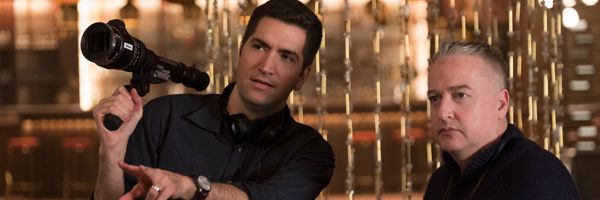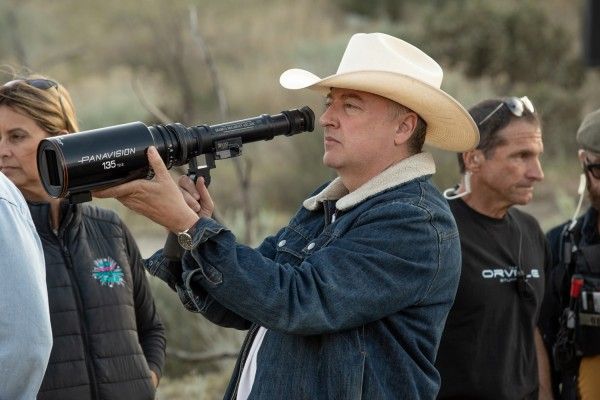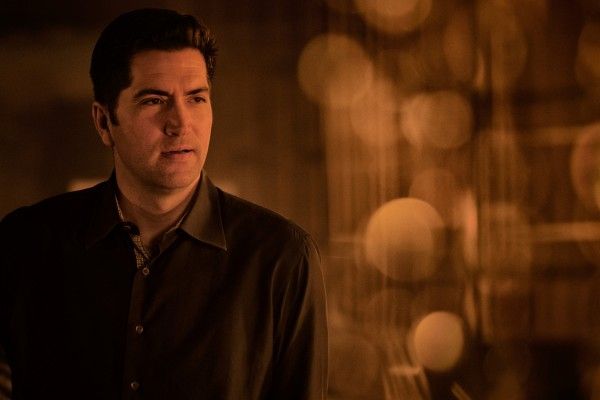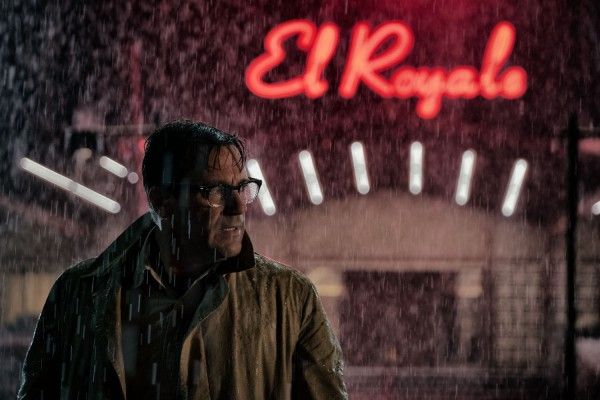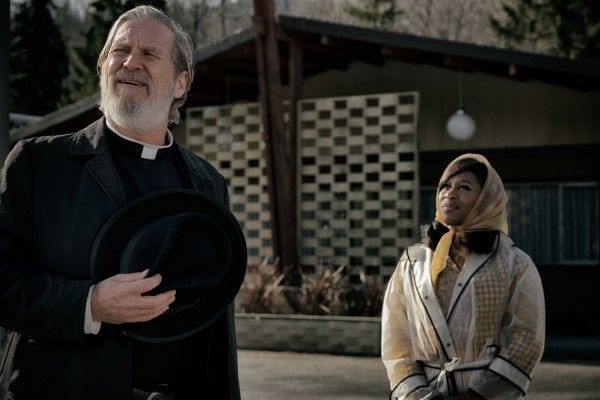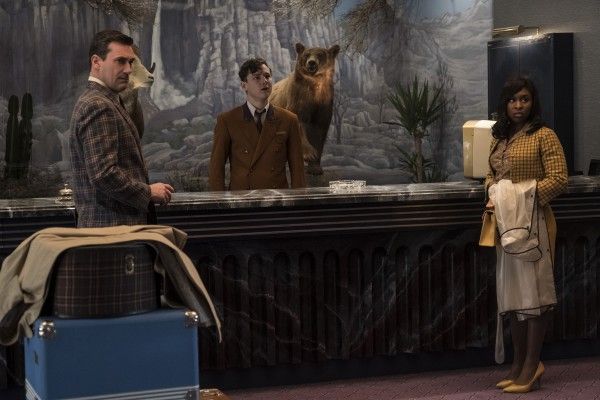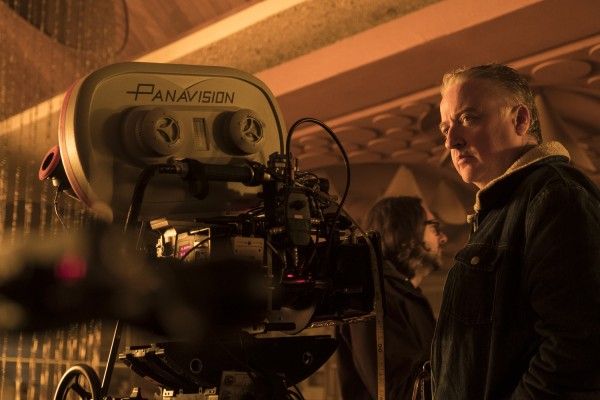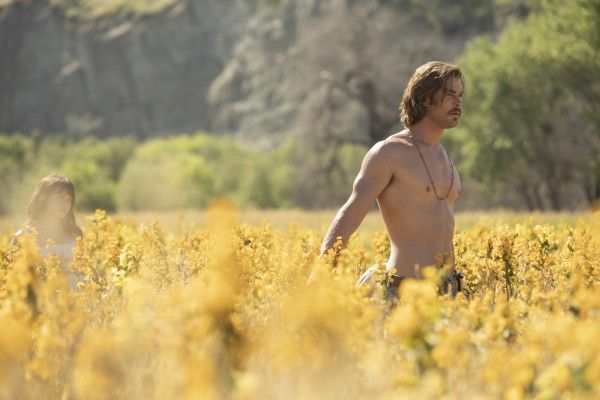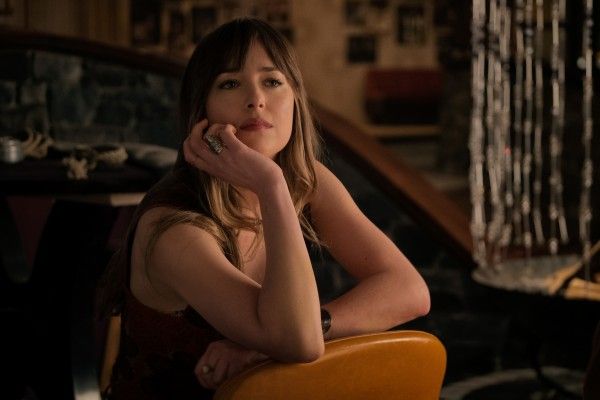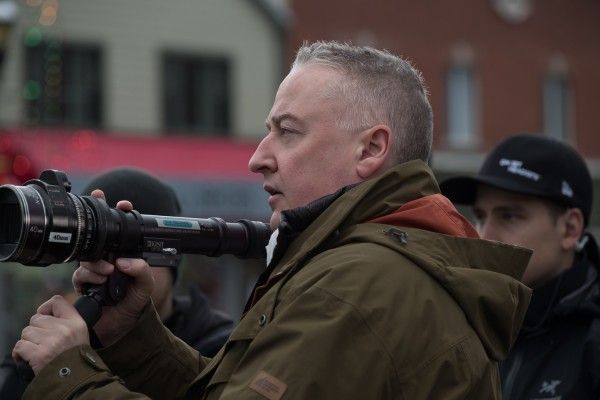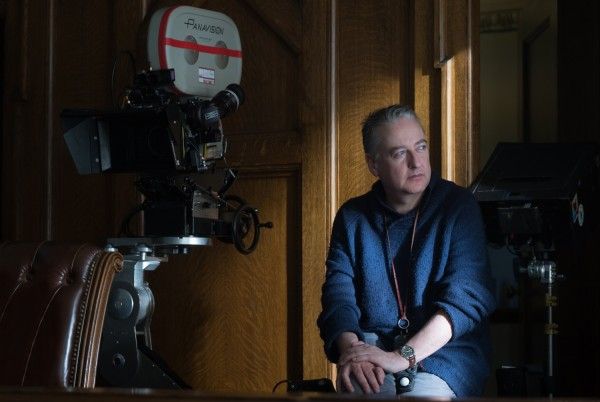When you think of versatile cinematographers, Seamus McGarvey is a name that immediately comes to mind. While his work on films like High Fidelity and The Hours was noteworthy, McGarvey really turned heads with his stunning photography for Joe Wright’s 2007 film Atonement—which involved the now-iconic Dunkirk oner. Since that time, McGarvey has traversed a variety of genres while never forsaking his artistry. Whether it’s We Need to Talk About Kevin or Godzilla or The Greatest Showman, McGarvey’s keen eye and penchant for complex shots shines brightly.
Most recently, McGarvey teamed up with The Cabin in the Woods filmmaker Drew Goddard for the rich, surprisingly emotional thriller Bad Times at El Royale. The original film (which Goddard also wrote) tells the story of a group of strangers who cross paths at a unique motel on one fateful night in the late 1960s, only to discover that not a single one of them is who they initially appear to be. The film is packed with delightful twists and turns, but it’s also a refreshingly complex and thematically hefty character piece, with stunning performances from actors like Cynthia Erivo, Jeff Bridges, and Chris Hemsworth.
With Bad Times at the El Royale now playing in theaters everywhere, I recently got the chance to speak with McGarvey for an extended, exclusive interview about his work on the film. Given that Bad Times is one of my favorite movies of the year, and since I’m a huge fan of McGarvey’s work in general, I jumped at the opportunity. During our wide-ranging interview, the cinematographer spoke at length about his collaboration process with Goddard, honing in on the story’s metaphorical and allegorical imagery, how they shot that stunning long take, how the film’s music impacted his visual decisions, why shooting on film instead of digital was essential, and he also got into spoilers to discuss the film’s finale.
McGarvey was incredibly gracious with his time and also spoke about his work on The Avengers, and what it was like to collaborate with Joss Whedon on a Marvel movie before Marvel was, well, Marvel. And McGarvey indulged my questions about his work on Joe Wright’s Pan, a film I find to be fascinatingly ambitious.
If you’re a fan of McGarvey’s work or Bad Times at El Royale, I’m confident you’ll find what McGarvey has to say here to be extremely enlightening and insightful. Check out the full interview below, and if for some reason you still haven’t seen Bad Times at El Royale, I highly suggest doing so while it’s still in theaters.
How did the project first come to your attention? Because I know Drew wrote the script on spec and the whole thing just kind of materialized very quickly.
SEAMUS MCGARVEY: Yeah, I had met Drew when he came on the set of The Avengers. He and Joss Whedon are friends. So I met him very briefly at that time. Then when I was doing The Greatest Showman, one of our executives from Fox, Fred Baron had said, “I've got a really interesting, quirky script from Drew Goddard” I love his work. I loved Daredevil. I loved Cabin in the Woods, which was one of my favorites actually. So I just jumped at the chance to read this and when I read it, it normally takes me a long time to read a script from a cinematographic perspective because I cannot help but chew over each scene and imagine it in a photographic way. But in this one, I just kind of hurtled through it because it was un-put-down-able. It was really one of those scripts that gripped my imagination. Not only that, but it was so beautifully written and obviously written from one voice.
You know, you can normally tell when you read a script, or you can tell the kind of kaleidoscopic inputs that sometimes appear and make a script a clunky read. But this one was so wonderfully cohesive and intriguing that I finished it in the same time that it probably takes you to watch the movie. And I rang up Drew right away and said, “Please, can I do this?” So we met in Los Angeles and we got on well and he offered me the film.
I'm always curious with cinematographers and directors, what those early conversations are like and how they compare with the finished film. So, what were kind of your initial conversations with Drew like, about what this project should look like and did that evolve or change much once you guys actually got on set?
MCGARVEY: You know, it didn't change much when we got on set. Obviously the discussions became more physical and real because we have the tangibility of a set to work in when we got on set. But in advance of pre-production, Drew is an incredibly visual filmmaker and he had such a clear notion of how he wanted to approach the film visually. Sometimes people write that directly into the script and that can be a distracting part of the read. Drew hadn't done that as vocally as some do. But when we sat down with Martin Whist, the production designer, and Danny Glicker, the costume designer, he was so vivid about what approach to take in terms of color and design. How design and photography kind of intersect and the photographic language of the film. The set up, the shifts that gradually occur, both tonally in terms of the milieu, the weather change, the darkness encroaching, and how that would be enhanced and embellished by the cinematographic approach. The choice of lenses, the type of movement we would do, and how that would connect with design.
So, a big thing was the kind of trajectory, like from light to dark. Obviously, if you loved the film, you know that the allegory is pretty heavy in this one. It's full of many metaphors and light and darkness being kind of essential elements in terms of the religious imagery that was used throughout the film. So starting the film in brightness and sunlight and with vivid color and with a kind of levity to the camera movement and camera approach was something that Drew initially wanted to set up, so that an audience was kind of invited into the film with a certain amount of allure and then as things start tightening, as the screw starts tightening on the drama, the rain starts coming, the elements of the darkness, and we start to get closer and employ different techniques of lighting as well, to create a sense of foreboding I suppose.
Yeah, I noticed that. There's a lot of dynamism to this film, and I know that probably was a little tricky to pull off because the film largely takes place in one setting. I mean, there are different rooms, but you're dealing with one set that you're kind of introduced to at the beginning of the film and you have to make that a visually dynamic experience throughout the entire film. How did you go about doing that? Ensuring that as an audience member, it would be dynamic to watch?
MCGARVEY: Well the set was one place, it was all built on an interior at Mammoth Studios in Vancouver. So even the night exteriors were shot on that covered set; even all those big rain scenes, we had a massive rain rig that was designed by Martin Whist’s brother, Joel, the special effects supervisor. And I suppose the gift for me in the film, when you're working in that one space for a protracted period of time, is you have to be really in sync with the production designer. And I suppose that Drew's cues were so strong to both Martin and to me, that every place we pointed the camera, there was a frame there. I mean, you could almost spin the bottle, spin the camera and land on something that had interest. It really was as glorious a set to shoot in as that. And obviously we were a bit more precise with our choices of lens and mise-en-scene, but throughout the film, throughout the set, there's a very sort of distinct imagery.
What was your relationship like with the production designer? Because again, it's one setting, but it's very meticulous when it goes to different rooms. I mean, you open outside in the light in the lobby, but then you're slowly introduced to the rooms themselves, and then of course, the back room.
MCGARVEY: Well, it was complex, and that idea of perspective and looking, and the sense that if the camera is an eye as well, and working with the camera as an objective and as a subjective device. We talked at length, Drew and I and Martin about that. Obviously there's the big shot in the corridor where Laramie, Jon Hamm's character, discovers this observation corridor with the cameras and the windows through to the rooms. And you know, it's a very long shot, it's over five minutes, and it was tremendously complicated to set up and required great collaboration with the design and art direction to make sure that we had all the elements we needed. Because we were looking, pretty much, in 360 directions in that very dark corridor into rooms that were lit.
One thing in particular that I discovered through testing was that I couldn't extract a reflection off of Laramie's face as he looked into the room, which was crucial to see what he was looking at and see his reflection in an over shoulder shot. So I did various experimentation and found half silver glass that would allow me to pick up some reflections, so it was at a 30% reflective glass, almost like a two way mirror, that was allowing him to look into the room and still get enough light on his face to get a reflection of it. So those were quite expensive panes of glass, when they're that size, so that was one thing that we said early on, that I know that this is a few thousand pounds per sheet but this is an integral element to the drama, so it's a good investment to make.
That shot is incredible.
MCGARVEY: Oh, thank you very much. We shot, believe it or not, 27 takes. I remember in Atonement we did like three takes or four but we used the third take. This one we used take 25, is what I've heard from Lisa Lassek, our editor. We actually shot 27 takes on that, which was hard because for Cynthia Erivo, she was singing live throughout that scene. So it was a really, really tricky shot to pull off. But I must say, I had a great grip team. Ryan Monro was the dolly grip, and we worked with a remote head, stabilized head, and the operator, the focus puller, they were all all like this sort of a one man band with Jon Hamm. Because we talked about other ways of achieving that shot, possibly with some sort of an almost motion control device, and there was no way, because you really need to be in tune with Jon's movement. He’s such a pro in terms of hitting marks and movement throughout, but you need to be live to their movement and to go with it. So that was the decision was to just go with a dolly where the grip and the operator can really react to the movements of the actor.
That shot is incredible from a technical perspective, and my jaw was on the ground. But it also isn't just one of these things that's meant to look cool. It's very in line with the film's themes, and that's one of the things I wanted to ask you about, is that thematically, so much of the film is about voyeurism and watching from afar. Right from the opening shot where you're an objective viewer. How did that manifest into your approach to telling the story with the camera?
MCGARVEY: Well there are times that we played with the celestial perspective. There are top shots reminding of that kind of “God is watching”-type of vibe, and when the priest, Jeff Bridges, is digging up in Darlene Sweet's room, you cut to a top shot. There's a few instances of those in the film, where we've got aerial perspectives—in the Vietnam flashback for Miles, and when the priest is knocked over, it's a top shot. These are the Eye of God and throughout the film we have those perspectives that are out of distance, then sometimes are shot through cruciform images. It may sound corny but these were really pre-ordained or pre-saged by Martin and Drew to remind us of these thematics of good, evil, truth, fiction and the elemental things of light and dark and fire and air. I mean, all of those things come into it as bold thematics.
But yeah, in terms of the perspective, we didn't adhere the camera to a particular point of view. Although, when we do deal with each character, there's more proximity, if you like, to the character when we're within their world. There's more of an intimate feel, both to camera movement and to the close up lensing of those moments with each character. And then a lot of the ensemble pieces that show the interaction between the characters are shown in more of a grand plan, they're wider shots. We shot in anamorphic, we shot on film. So we were able to use that lovely 2.39:1 aspect ratio to place people in the frame and to choreograph actors within that with movement. So that people could move into closeup and move back into a wide, to make shots that evolved and showed an ensemble piece, and then we could distinguish the individuals within that.
That kind of drills down to another theme of the film, which is that looks can be deceiving. And the opening scene in the lobby, with all the characters arriving for the first time, is pretty breathtaking. But once you've seen the film, you think back to your first judgments that you make about these characters when they're first introduced and then you realize that your judgments were off. I was wondering if you could talk a bit about constructing that opening lobby sequence.
MCGARVEY: It was complicated and when I read the script initially, it was the one scene where I kind of felt the longueurs and Drew really assuaged my fears about that by saying, look, we're going to have great actors, number one, but there's gonna be incredible tension between the various looks and the spaces between the looks, it's not just one poking head after another. And that was what he really did brilliantly in the room. Because we shot that opening scene over, I think it might have been even a couple of days. I remember it was almost 16 pages. And it was fantastically complicated in terms of the staging, the camera movement, the changing of the eye lines. You couldn't really block shoot it in your normal way that you might do these big scenes.
We shot with two cameras for a lot of that scene so that we could at least get two sizes on each character. Like a two shot and a mid shot at the same time. So that helped us. But we also had the advantage of doing a day's rehearsal, which was absolutely intrinsic to being able to make our day if you like. And just sort of sit down with the A.D. and really be specific about what our shots were and what the origin of shooting would be. So I love doing that because it means that you can just relay it out to your crew and they know what we're trying to achieve in the day and it really sort of maximizes your time and maximized Drew's time with the actors.
It really sets the movie off on a really great foot.
MCGARVEY: Drew was very clear with each actor what the roles they were playing and they were almost like they had to be ciphers of their actual characters, or lies. Or sort of like badges are emblazoned across them. Obviously Laramie's character is a complete construct but also the priest. They were all kind of living a lie or not in those opening scenes which I really love. It's slightly heightened reality and you think, well this feels very much like operatic almost.
Music is a really essential part of this film and beautifully so, both with the soundtrack and the live singing. How did that impact your approach to shooting certain scenes?
MCGARVEY: It was lovely. I mean, I love how music affects choreography and the movement of the camera and the movement of the characters. And you know, I come from working with music, I've done a lot of music videos in my time, and there's something really special that happens, particularly in the scenes where Cynthia was singing, where we have live singing on set, and the way the camera moves towards an actor. There’s a synthesis between camera movement and actor's movement. But not only did we have her wonderful live singing, but when we had jukebox music going on—like one of my favorites is obviously the terrifying moment of Billy Lee, when Deep Purple comes on. It's funny, it's like portentous, it's terrifying as well but weirdly alluring because of Chris Hemsworth's physique, then performing some strange dance. But that was one of my favorite moments. Just throughout it we did play music quite a lot and Drew would sometimes, even when we were setting up, play some music which really helps to create a buoyancy on the set and the sense of camaraderie I suppose too.
Yeah, it creates a really wonderful effect throughout the film. I loved it. You mentioned earlier that you shot on film, which is something that I could definitely tell while I was watching the movie and it kind of made all the difference. You feel the richness and the texture of the frame, but this was also an original story and I know film costs more to use. Did it take much convincing on the studio's part to let you guys shoot on film?
MCGARVEY: Actually it didn't. I must say that it normally is an argument or at least an extended debate. Once Drew and I decided that we wanted to shoot on film, the matter was never raised again. And we had complete support of Fox and our producers. In the end, even though we actually shot quite a lot of film, with all the extended dialogue scenes, we shot nearly a million feet of film. And it still didn't work out significantly more expensive. I think that the investment was worth it, just as you said, texturally. The discipline of shooting, the changing of the mags, the fact that you just don't run the mags or takes for hours and hours and hours, which sometimes happens, especially in these big dialogue scenes. I've been on sets where we've had like five pages of dialogue and we kind of do a master that lasts 80 minutes, and that's just, it's impossible to keep energy up and for actors and to focus after a lot of takes. So, there's something really beautiful about how we work with film, the discipline.
There's literally money burning so the pressure's on.
MCGARVEY: Yeah. You know, I love the attributes of film, I love the grain. But the last few films I've shot—Nocturnal Animals I shot on film but this one had a lot of low key elements to it and you really see the dance of the grain in there, in the blackness. And you know, sometimes people look at it and go, oh gosh, what's that? Because people are kind of not used to seeing it these days. They're so used to the kind of slickness of, and the dead blacks of digital. I really like this, particularly in the flashbacks. There's something about film that allows you to, don't get me wrong, but torture the medium a little bit. So you can really kind of rest different, very disparate looks out of situations. Whether it's a flashback in full sun or a really low key, velvety black nocturne. I just love the way, particularly, it records color, especially the color red, which sometimes on digital, disintegrates a little bit. It buzzes, there's a kind of weird electronic buzz to deep colors that are sort of very saturated, like reds and deep blues. And on film it just appears almost like a stained glass window, it's really beautiful.
Yeah, I can see what you're saying about the flashbacks. The film looks very dynamic, and sometimes with digital, even though you're going from a very dark scene to a very brightly lit scene, or maybe you're going from fire to snow, it looks a little same-y. Whereas, in this film, there's a really great dynamism to that. When you cut to a flashback, you just feel like you're in a different world.
MCGARVEY: Yes! Exactly.
***BEGIN SPOILER TALK***
Going into this movie, I had been a fan of Drew's work and I saw the trailers and so I expected to have a really good time, and I did, but I didn't expect to be so emotionally moved by the film. It really puts in the work to make you empathize with these characters and there are a number of scenes in the third act that are significantly emotional. I was curious how you went about choosing how to shoot those death scenes in the finale. Because they're really impactful, it doesn't feel perfunctory like some other movies do. It really hits you in the gut.
MCGARVEY: Well thanks for that, that's a real compliment. We rehearsed it without the emotion so that we knew where we would be in terms of the cameras but Drew really didn't want to push the actors in rehearsal. He wanted a sense of capturing it, that it was effectively like a life moment that was kind of captured as a life expired. So we shot it with two cameras, quite close up. We did the wides first. And obviously all that flame in that final sequence is real flame, so that was a special effect. So it was just fantastically hot and scarily dangerous. You really felt that the whole place could go up. So there was an urgency to the performance. So we actually shot those scenes, like the one of Jeff Bridges underneath, that was hand held. We were hand holding them close in his face. There was a top shot on Miles tight, and then we did off a crane, a higher angle top shot again, right over the line of Nevada/California, that had this kind of cruciform shape to it to remind us once again of that sort of current imagery.
But the actual performance of that moment was really told in three closeups between Bridges, Erivo and Pullman, you know. Drew told it that way and it was predominantly in closeup. So it actually, although Drew was very concerned about getting it right, we did it very quickly. You know, it was only a couple of takes really. Because when you're working with actors of that caliber, they just get it. And I think it was the imperative and the urgency of the fire as well, people just don't want to fuck around. Like, it’s not, “I'm gonna do another one just for me,” it's like get me outta here! It's 120 degrees.
***END SPOILER TALK***
That's funny. Well, it's incredibly impactful. Because you know, from the trailers, it seems like a fun, twisty little movie, but you guys really put in the character work and it makes all the difference.
MCGARVEY: Oh that's great! I'm so glad that that worked for you as the audience member because there's always the danger with films that are intricate and layered and you know, like a Rubik's cube of elements that the cleverness can potentially overtake the heart, and that was Drew's big concern. He wanted to make an intelligent movie. He wanted to make a complex movie. Like the way writers can play with time and with structure in a way that few filmmakers do. You know, obviously this is like the greats, which I consider Drew to be frankly. He was concerned that it just still had to have that emotional truth and that was his biggest concern.
He was always, even when it was talking about design or color or our lenses, he never wanted to be flash or symphonic photographically, just for the sake of it, even though there were times where we really could have been. He wanted a veracity to underscore the whole film. Because for him, the very prescient and modern themes of the film, in terms of the #MeToo movement and about violence and about war, were subjects so dear to his heart that he wasn't gonna trivialize them with spectacle.
I definitely really appreciated that. I'm also curious, I mean the film feels very tightly constructed, but were there any major deleted scenes or sequences that didn't make the final cut? Or did you shoot alternate versions of scenes that didn't get in?
MCGARVEY: I'm trying to think. I think there were a few scenes that were cut that I hope make it to the DVD extras. You always hope that those things make it. There was a scene between Billy Lee and Emily Summerspring in a forest where he climbs a tree. It was a really beautiful scene but there just wasn't enough time for it in the movie, which was already running long. And within scenes there were truncations and shortenings of scenes. But actually there weren't that many major excisions from the original script. I think that it was purely tightening the material that we had.
That makes sense. There are a number of films I'd love to ask you about, but I'm really curious about your experience on The Avengers. Which, I mean we know that movie as this massive hit, but when it was shooting, no one really knew for sure if this big gamble was gonna work for general audiences. What do you remember about that shoot and working with Joss and basically inventing how a superhero crossover movie works?
MCGARVEY: (Laughs) Yeah, well, I mean I was so surprised to be asked even in the first place because I didn't know one superhero from another. I wasn't a comic book fan really, although I was really interested in it and its mythology. You know, on where those stories all come from essentially anyway. So, I've always loved Joss' writing, so I was just really keen to work with him. And the to work on a film of that scale, I mean, I hadn't really done that before. And especially working with visual effects, which was going through a real upsurge in what could be done.
So, for me it was an incredibly steep learning curve but also, it was exhilarating. I mean, I loved every second of being on that film just because of the challenges that I faced and the complexity. I loved all the disparate story lines sort of coalescing. And to have—it’s actually something that I really love, is that when you're working with the writer who's also the director, because they're so in touch with the story and they can react to how actors shift the story in a particular direction. They can tailor the rest of the script so that it bends with these minute shifts and direction that happen naturally sort of on a movie as you're shooting it. So I loved that one.
And I know that Marvel took a direction into a darker, more sort of almost cartoony style after that, which I actually quite like as well, but we were going for the happenstance of this happening in the real world. That was one of Joss' first cues to me. He said I want this to feel like these guys are really amongst us. And so we weren't sort of amping up the color, the saturation or contrast or the filament. It had a very naturalistic pattern I suppose. Which was lovely to do. But I loved it. It was one of the best experiences on a film that I ever had.
Marvel is also known for working additional photography into their schedules. Just kind of the idea of, we'll shoot it, we'll do the edit and then we'll go back and do whatever else we feel the film needs. Was that a unique experience for you? Was there much kind of added after the fact or re-shoots and stuff?
MCGARVEY: We did, I think we did like days of extra shooting.
Oh that's not bad.
MCGARVEY: It wasn't actually. It wasn't reshoots, it was additional little scene-lets, that are cut into a particular scene to give the editor an extra bit or insert or that sort of thing. It was really minimal stuff after. So yeah, it was unusual that way. I mean the last few that I've done I haven't really done extra shooting but I've heard it's like par for the course. You just almost shoot the same amount of time on a movie in additional photography or reshoots.
Was there kind of a dictation from Marvel of making The Avengers visually look as a piece of a whole with the other films or were you kind of left alone to craft your own vision for that?
MCGARVEY: Yeah, well you know, that was one of the first ones really. So, we were kind of out on our own. Marvel were very supportive of us and they just kind of let us run with it. Although they did come in after the first few weeks with certain notes and guidance towards how they wanted it to feel. That was as much with design as with photography or direction. But that's good. I mean, I love that. That sort of input. It's great when you have creative producers who are keeping an eye on things and supporting and embellishing alongside you. Much better that than an us and them kind of scenario, which can sometimes happen.
Yeah, exactly. Well, another film of yours that I'm actually quite fond of is Pan.
MCGARVEY: Really?! You're in a very small minority.
I'm one of the few. I really liked the ambition of that film. But I heard there was a darker version that never saw the light of day. Is that true or was that just a rumor?
MCGARVEY: I don't know about that. Because I don't get involved really in the editing process. I saw an initial preview that was slightly different than what we ended up with and again, there wasn't additional photography on that film. But I don't know what happened with that film because I must say, I liked it but I think it tonally perhaps struggled between adult themes and childhood kind of aspirations for the film. It sort of hovered between the two, so it fell between two stills perhaps? Coupled with the fact that the studio had bad previews and decided maybe not to push it as much as they might have.
But it was a shame because it knocked the wind out of Joe Wright's sails for a bit and it was only when—his next film after that was Black Mirror with TV, “Nosedive,” with a much lower budget, a real kind of a rush, push, and a shove Netflix special. And he really got his mojo back with that film and got his fingernails dirty and it wasn't the behemoth effect movie that kind of knocked him for six, so I think that was a good thing, a good decision for him to make to do that one next.
Yeah for sure, and then obviously, he recovered with Darkest Hour which I think is terrific as well. I'm just a big fan of his and you know, Joe Wright making a kids Peter Pan movie. I’m there.
MCGARVEY: Yes. It was great. There were so many great elements and great ideas and obviously Hugh Jackman, who I've worked with since on The Greatest Showman was a joy to work with. He really is the greatest. There's so much to love about the film and it's extreme characterizations and big sets and I mean it was a cinematographic fair ground ride for all of us. But yeah, I mean, there are some ardent fans of that film but they're few and far between.
Bad Times at the El Royale is now playing in theaters everywhere.

